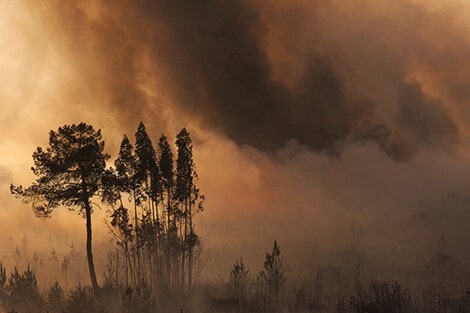Wildfires threaten more than land and homes. The smoke they produce contains fine particles (PM2.5) that can poison the air for hundreds of miles. Air pollution from the 2016 Fort McMurray fire in northern Alberta, Canada sent people in Michigan to the hospital with respiratory illnesses.
In a new study, researchers from Harvard University, in collaboration with colleagues at Yale University, coined the term “smoke waves” to describe two or more consecutive days of unhealthy levels of PM2.5 from fires. The study found that across the western U.S., climate change will likely cause smoke waves to be longer, more intense, and more frequent—putting more communities at risk of exposure to dangerous levels of pollution.
“Climate change is a public health crisis and it’s happening right now,” said Francesca Dominici, professor of biostatistics and senior associate dean for research at Harvard T.H. Chan School of Public Health and coauthor of the paper. “Asthmatic kids are going to the hospital today in California because of the smoke from wildfires. If we can figure out who is most at risk, we can start thinking about smoke evacuations and early alert systems for hospitals and local primary care physicians.”
The study was published online July 30, 2016 in the journal Climatic Change. It includes a watch list of hundreds of counties in the western United States at the highest risk from wildfires in the coming decades.
The team used a fire prediction model and advanced atmospheric modeling to separate pollution caused by wildfires from other pollution sources and track the likely movement of smoke. They found that between 2004 and 2009, about 57 million people in the western U.S. experienced a smoke wave.
They estimate that between 2046 and 2051, more than 82 million people will likely to be affected by smoke waves, mostly in Northern California, Western Oregon and the Great Plains, where fire fuel is plentiful.
Of the 561 counties the team studied, 312 are expected to have more intense smoke waves in the next 30 years.
Estimating at-risk areas down to a county level will help the U.S. Forest Service “prioritize efforts to reduce wildfire risk, such as setting prescribed fires to clear out dry underbrush,” said Loretta J. Mickley, senior research fellow at the Harvard John A. Paulson School of Engineering and Applied Sciences (SEAS) and coauthor of the paper.
Among the areas estimated to face the highest level of risk of wildfire smoke exposure in the coming decades are heavily populated counties such as San Francisco County, CA; King County, WA; Alameda County, CA; and Contra Costa County, CA.
The team estimated that about 13 million more children and seniors — who are at higher risk for respiratory illness—will be affected by smoke waves compared with the present day.
“In the coming decades, we will be seeing the significant human health consequences from these extreme events in a changing climate,” said Jia Coco Liu, a recent PhD graduate at the Yale School of Forestry and Environmental Studies and first author of the paper.
If our reporting has informed or inspired you, please consider making a donation. Every contribution, no matter the size, empowers us to continue delivering accurate, engaging, and trustworthy science and medical news. Independent journalism requires time, effort, and resources—your support ensures we can keep uncovering the stories that matter most to you.
Join us in making knowledge accessible and impactful. Thank you for standing with us!


Not a hoax. Climate has been changing for millions of years. Periods of wildfires being higher and lower. We could be in a higher period right now.
Good thing all of that climate change is a hoax right…